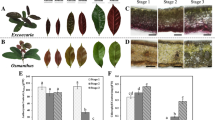Abstract
Red pigmented bodies were found in tepal cells of threeRebutia species, i.e.,R. grandiflora, R. hyalacantha andR. krainziana. The pigmented body within the vacuole was spherical and normally one per cell. It contained betalains which were validated from the visible spectra of tepal extracts and microspectrophotometric survey on vacuoles. Such a particular red pigmented body has already been found in some anthocyanin-producing plants, and called “anthocyanoplast”. Now, a similar structure has also been found for the first time in betalain-producing plants. Therefore, it may be called “betalainoplast”. InR. grandiflora, yellow pigmented bodies which were not well characterized due to their minimal size were also present as a betalainoplast.
On the other hand, pigment-crystals were frequently present in the cells having flavonols such as those in pale yellow tepals of fourAstrophytum species, namely,A. asterias, A. capricorne, A. myriostigma andA. ornatum, with or without a trace of betalains. Yellowish crystals were determined as the crystal mass of quercetin by the UV spectral analysis and careful comparison of chromatographic properties with an authentic specimen.
Similar content being viewed by others
References
Blank, F. 1958. Anthocyanins, flavones, xanthones.In. K. Paech and M.V. Tracey, ed., Encyclopedia of Plant Physiology, vol. 10. Springer-Verlag, Berlin.
Iwashina, T. andS. Ootani. 1986. Distribution of flavonol glycosides and their sugar-free forms in subfamily Cereoideae. Ann. Tsukuba Bot. Gard.4: 25–42.
—,—,T. Gotoh andN. Kondo. 1982. Distribution of flavonol glycosides in the sub-family Cereoideae and some chemotaxonomic consideration thereof. Sci. Rep. Res. Inst. Evolut. Biol.1: 83–102 (in Japanese with English summary).
—,— andK. Hayashi. 1983. Microspectrophotometric measurement of absorption spectra of vacuoles and plastids in living cells, as an effective tool for prompt discrimination of pigmental ingredientsin situ. Jap. J. Breed.33: 457–467 (in Japanese with English summary).
—,— and —. 1984. Neochilenin, a new glycoside of 3-O-methyl-quercetin, and other flavonols in the tepals ofNeochilenia, Neoporteria andParodia species (Cactaceae). Bot. Mag. Tokyo97: 23–30.
—,— andN. Kondo. 1985. Flower colors and their betalain constituents in Cereoideae species. Sci. Rep. Res. Inst. Evolt. Biol.2: 95–118 (in Japanese with English summary).
—,— andK. Hayashi. 1986. Determination of minor flavonol-glycosides and sugar-free flavonols in the tepals of several species of Cereoideae (Cactaceae). Bot. Mag. Tokyo99: 53–62.
Küster, E. 1939. Über Vakuolenkontraktion und Anthozyanophoren beiPulmonaria. Cytologia10: 44–50.
Mabry, T.J., K.R. Markham andM.B. Thomas. 1970. The Systematic Identification of Flavonoids, pp. 3–164. Springer-Verlag, Berlin.
Metcalfe, C.R. 1985. Secreted mineral substances, crystals.In C.R. Metcalfe and L. Chalk, ed., Anatomy of the Dicotyledons, 2 ed., vol. 2, p. 86. Clarendon Press, Oxford.
Nozzolillo, C. 1972. The site and chemical nature of red pigmentation in seedlings. Can. J. Bot.50: 29–34.
Ootani, S. 1973. Chemico-genetical studies on the flower colors and pigment components in wild and cultivated pansies, with special regard to their inter-varietal relationship. Rep. Inst. for Breed. Res., Tokyo Univ. of Agric., Suppl. for 1973.
Pecket, R.C. andC.J. Small. 1980. Occurrence, location and development of anthocyanoplasts. Phytochemistry19: 2571–2576.
Piattelli, M. andF. Imperato. 1969. Betacyanins of the family Cactaceae. Phytochemistry8: 1503–1507.
Reznik, H. 1957. Die Pigmente der Centrospermen als Systematisches Element II. Untersuchungen über das ionophoretische Verhalten. Planta49: 406–434.
Wollenweber, E. 1978. The distribution and chemical constitutents of the farinose exudates in gymnogrammoid ferns. Amer. Fern J.68: 13–28.
— andV.H. Dietz. 1981. Occurrence and distribution of free flavonoid aglycones in plants. Phytochemistry20: 869–932.
Author information
Authors and Affiliations
Additional information
Contribution from the Research Institute of Evolutionary Biology, No. 86.
Rights and permissions
About this article
Cite this article
Iwashina, T., Ootani, S. & Hayashi, K. On the pigmented spherical bodies and crystals in tepals of cactaceous species in reference to the nature of betalains or flavonols. Bot Mag Tokyo 101, 175–184 (1988). https://doi.org/10.1007/BF02488894
Received:
Accepted:
Issue Date:
DOI: https://doi.org/10.1007/BF02488894




